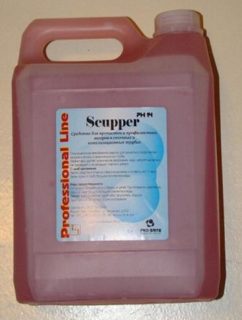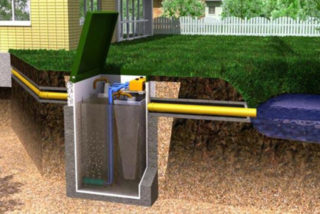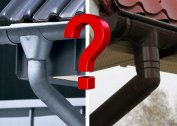Sooner or later, in a private house, not connected to the central sewer and water disposal, there is a need to clean the cesspool. It is not always possible to carry out its maintenance with the help of suckers, so the owners are faced with the question of alternative cleaning methods.
When to clean a pit
 As the cesspool is used, not only liquid waste is accumulated in it, but also the accumulation of fat deposits on the walls, which will make it difficult to clean and accelerate the filling of the tank or well. In addition, a mixture of excrement, household chemicals and food waste can harm the environment and residents of the house, since during the fermentation process, poisonous gases accumulate in the pit. There are several indicators that you need to clean a cesspool:
As the cesspool is used, not only liquid waste is accumulated in it, but also the accumulation of fat deposits on the walls, which will make it difficult to clean and accelerate the filling of the tank or well. In addition, a mixture of excrement, household chemicals and food waste can harm the environment and residents of the house, since during the fermentation process, poisonous gases accumulate in the pit. There are several indicators that you need to clean a cesspool:
- the appearance of a fetid odor;
- accumulation of silt-like mass on the bottom and walls;
- accumulation of insects over the drain hole;
- slow outflow of water in the plumbing, brought to the pit.
In general, a pit of up to 2 cubic meters can be used without cleaning for several years, however, it is much easier to eliminate small volumes once a year than large ones once every five years. Performing preventive cleaning will extend the life of the cesspool several times.
Non-pumping cleaning methods
If there is no technical possibility to adjust the sewer machine, cleaning can be carried out in the following ways:
- using chemicals;
- with the use of bioactive drugs;
- folk methods.
Each of the methods has its pros and cons, and the choice depends entirely on the owners of a private house.
 Chemical compounds work on the basis of the interaction of reagents with the contents of the cesspool, as a result of which simple organic compounds are formed. Despite its apparent simplicity, this method is not the most environmentally friendly and safe in relation to the residents of the house.
Chemical compounds work on the basis of the interaction of reagents with the contents of the cesspool, as a result of which simple organic compounds are formed. Despite its apparent simplicity, this method is not the most environmentally friendly and safe in relation to the residents of the house.
Formaldehyde and quicklime were previously used to remove waste in cesspools. Currently, they are prohibited for use because of their high toxicity, and in their place came more modern and relatively safe drugs:
- ammonium compounds have a low price, but are toxic to the environment. Their use is not recommended for metal cesspools due to the high risk of metal destruction. The clarified cesspool waters still need removal and special disposal. The presence of household chemicals in wastewater significantly reduces the activity of this group of chemicals.
- Nitrogen oxidizers are considered the most environmentally friendly. A significant minus is the high cost. Their effect does not decrease if there are household chemicals and food waste in the cesspool. They decompose biological inclusions and deposits, neutralize unpleasant odors and destroy the larvae of harmful insects.
- acid cleaners are suitable for metal closed cesspools. In their action, they are similar to nitrogen oxidizing agents - they decompose sludge masses, solid waste, plastic, and are not sensitive to residues of cleaning and detergents. They destroy bacteria and insects, eliminating the cause of the fetid odor.
Chemical reagents are used most often in the cold season, because they are not afraid of low temperatures and sudden temperature changes. Available in various forms - in the form of liquids, powders, tablets, granules. Powders are suitable for dilution with water and drain through plumbing, tablets and liquid forms are placed directly in the cesspool.
 Biological preparations are the achievements of biotechnology and are divided into septic tanks and antiseptics.The composition of such funds includes special microorganisms that decompose solid and liquid human waste into water and sludge. Unfortunately, they cannot completely replace the mechanical cleaning of the cesspool, however, they can reduce the filling speed of the cesspool by almost half.
Biological preparations are the achievements of biotechnology and are divided into septic tanks and antiseptics.The composition of such funds includes special microorganisms that decompose solid and liquid human waste into water and sludge. Unfortunately, they cannot completely replace the mechanical cleaning of the cesspool, however, they can reduce the filling speed of the cesspool by almost half.
Bacteria that are part of biological products are divided into aerobic and anaerobic. Aerobic bacteria need an oxygen supply and act mainly on the surface of the pit. Anaerobic are used for pressurized cesspools and operate in the bulk of the waste.
Biological products operate in a certain temperature range from +5 to +30 degrees, and are suitable for use exclusively in the warm season. In hot weather, the cesspool with biological products must be shaded to prevent the death of colonies. Another disadvantage of this method is the need to regularly update the colony by adding drugs to wastewater. In addition, some types of bacteria are sensitive to the presence of chlorine in water and household chemicals.
Folk methods Cleaning the cesspool includes adding sawdust, tops of tomatoes or nettles to the pit. Sawdust and peat absorb the liquid component, but such holes need mechanical removal of the resulting content. The introduction of tops or nettles fights odors, but does not contribute to the mechanical disposal of waste.
How to reduce the frequency of cleaning a cellar
 Reducing the number of cleanings of the cesspool is laid at the stage of construction of the house and sewage system. If this has not been done, the most optimal will be the reorganization of the old cesspool into a septic tank with overflow. The first container is sealed, the second is permeable. Such pits are less susceptible to siltation, mechanical cleaning is very rarely necessary, and the effect of drugs in such types of pits is increased due to the manufacturability of the septic tank itself.
Reducing the number of cleanings of the cesspool is laid at the stage of construction of the house and sewage system. If this has not been done, the most optimal will be the reorganization of the old cesspool into a septic tank with overflow. The first container is sealed, the second is permeable. Such pits are less susceptible to siltation, mechanical cleaning is very rarely necessary, and the effect of drugs in such types of pits is increased due to the manufacturability of the septic tank itself.
It is important to properly insulate the cesspool and sewage system in order to avoid freezing of waste and damage to directly discharge pipes.
The use of biological preparations will reduce the frequency of mechanical cleaning of the pit and septic tank.
It is impossible to completely replace the mechanical cleaning of the cesspools - solid and silt deposits will accumulate and need to be removed from the cesspool. However, the use of chemical reagents and biological preparations will significantly reduce the frequency of the procedure and extend the life of the cellar or septic tank. So far, there is no complete alternative to pumping and mechanical cleaning of the pit.


